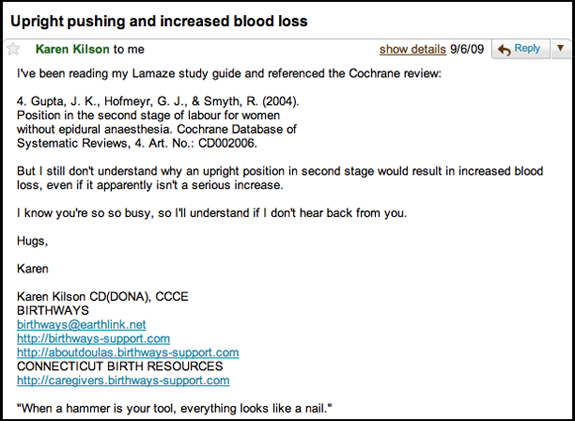April 07, 2010
Are upright birthing positions harmful?
By: Amy M. Romano, RN,CNM | 0 Comments
Just a few weeks before her death last year, Karen Kilson, a beloved local doula and childbirth educator, sent me this email:

She didn't hear back from me, because it was one of too many emails I let sit in my inbox until I had the time to write a coherent response. And in the meantime she passed away.
Karen was a life-long learner and was in fact studying to sit for her Lamaze Certification Exam when she died. She shared information as voraciously as she collected it. So in her memory, I thought I would respond to her email here on the blog as part of the Fifth Healthy Birth Blog Carnival.
Karen hit on an important conundrum. Unlike practices that have benefits and no documented harms, such as movement and upright positions in the first stage of labor, continuous labor support, and skin-to-skin contact after birth, the Cochrane Systematic Review shows that upright positions are associated with a statistically significant increase in the likelihood of blood loss exceeding 500 milliliters, the clinical definition of postpartum hemorrhage. I have in fact personally heard care providers citing this finding as a rationale for keeping women in the traditional stranded beetle position.
So, are women trading an increased risk of postpartum hemorrhage for the benefits of being off their backs?
A critical look at the evidence in context suggests that the answer is 'almost certainly not.' Here's why:
1. Some of the trials included in the Cochrane review used unreliable methods of estimating blood loss, such as simple visual estimation. This would probably bias against upright positions, since in addition to seeing blood loss, when the woman is upright you can hear it, too. However, the result was statistically significant even after the Cochrane reviewers excluded the studies that used clearly unreliable estimation methods.
2. Blood loss greater than 500 milliliters may be the clinical definition of postpartum hemorrhage, but very few women losing that amount of blood would exhibit symptoms or need treatment. After all, a healthy non-pregnant person donates that much blood at a blood drive, and pregnant women have 50% more blood than non-pregnant people, which their bodies are designed to get rid of after birth. A much more meaningful definition for postpartum hemorrhage might be 1000ml or even 1500ml, significant postpartum anemia, or need for blood transfusion. The only one of these outcomes that the Cochrane review reports is blood transfusion, for which there was no significant difference between upright and supine positions.
3. One study with particularly rigorous methodology found increased blood loss in the sitting or semi-sitting positions compared with recumbent positions, however the difference was observed only when perineal trauma occurred. This suggests that it is not the position the woman assumes in second stage but the position she assumes after birth and before necessary perineal repairs that contributes to excess blood loss.
Restricting women to give birth on their backs poses significant risks, including an increased likelihood of perineal trauma, a small increase in the likelihood of an instrumental vaginal birth, more fetal heart rate decelerations, and more severe pain. Then there are the intangible benefits, which come out loud and clear in many of the phenomenal contributions to the second stage Blog Carnival (which I will post at the end of the weekend). The statistically significant excess in an arbitrary amount of blood loss does not outweigh those benefits, whether or not the excess is an artifact of measurement errors. The excess blood loss seen with the combination of upright positions and perineal trauma underscores the need to minimize perineal trauma during birth. Effective strategies for reducing trauma include avoiding episiotomy, instrumental vaginal birth, or the combination of the two, supporting spontaneous pushing, and birthing the baby's head between contractions.
Tags
Second Stage Healthy Birth Practices Safety Labor/Birth Systematic Review Postpartum Hemorrhage